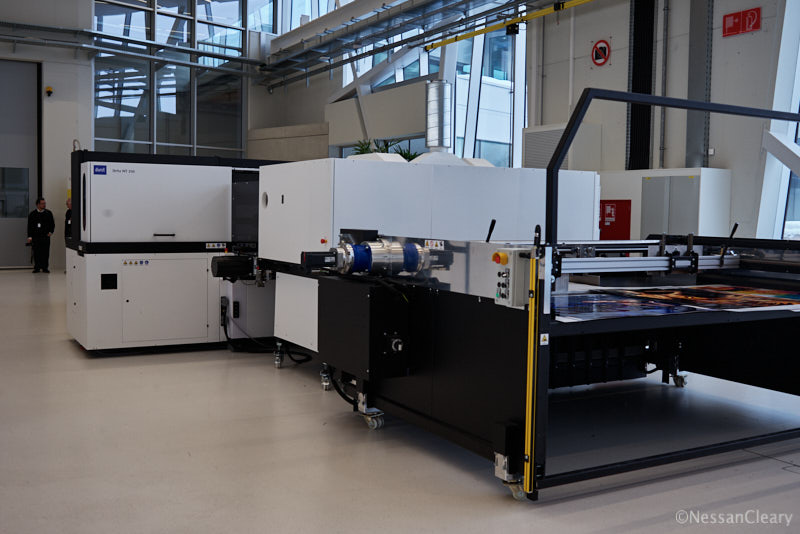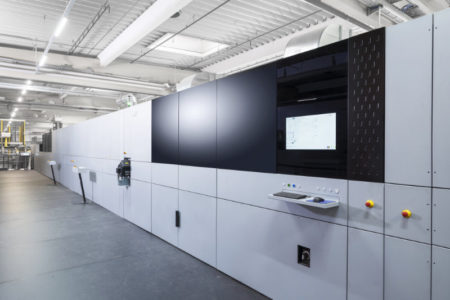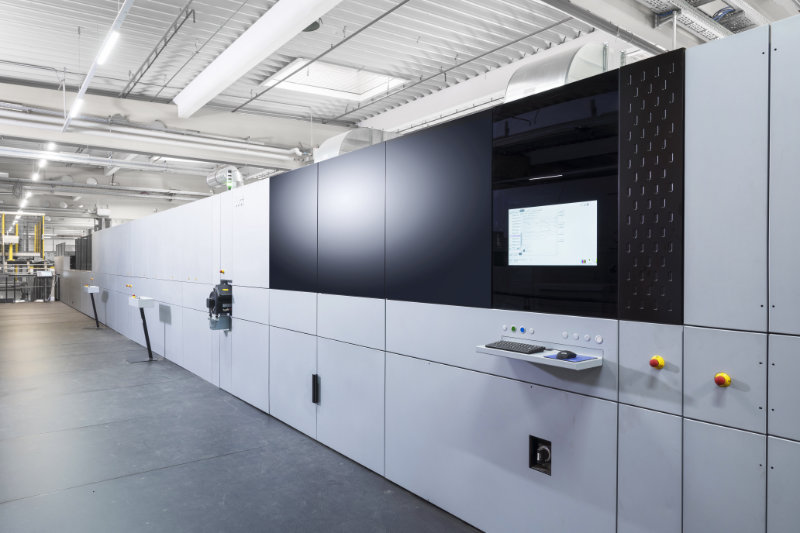Previously, I wrote about the Delta SPC 130 corrugated printer, developed by Durst and now sold through the Koenig and Bauer Durst joint venture. In this article I am going to cover the Water Technology ink that Durst created for that printer. However, this story also illustrates how Durst itself is evolving, from mainly being a wide format supplier to now also serving the packaging market.

Stefan Kappaun, Durst’s executive vice president of inks and fluids.
The Water Technology ink appears to be a hybrid resin ink with an aqueous carrier and having some of the properties associated with water-based inks – the lack of any odour – together with elements typical of UV curing, such as an overall robustness. It uses organic pigments but does not contain any monomers or mineral oils.
Stefan Kappaun, who heads up Durst’s ink and fluids, describes it in this way: “We are still working on a polymer technology, meaning that we have a water-based ink, we have dispersed a polymer in it, a macromolecular compound that is printed, that is thermally dried and for the last step of the printing process we have the UV sealing. This UV sealing cross-links the polymer chains that are already there and by that you get very good gloss and also very good scratch resistance without overcoating.”
There are two variations on the water technology ink, with WT SP ink designed for single pass printers – currently only the Delta SPC 130 – and the WT MP ink meant for scanning printers, and which is used in the WT250, based on a standard Durst wide format chassis. The WT ink requires both drying and curing. For the SPC 130, this starts with infrared heaters directly after printing to pin the inks and immobilise the pigments, followed by a hot air drying section to get rid of the water, then the UV curing.
It is said to have a wide colour gamut from the CMYK process colours. There’s an option to add light cyan and light magenta, which reflects Durst’s heritage in wide format printing where light colours are commonly added to help reproduce skin tones and to smooth gradients. At the end of last year Durst offered an alternative to the light colours with an option to add orange and violet, which can produce a wider colour gamut and is more suitable for the packaging market.
Durst has developed the Water Technology ink completely in-house as Kappaun explains: “We screened all the commercial solutions. We tried to work together with partners because when we start an ink development we never put all our eggs in one basket. We wanted to spread the risk, of course, but very soon we realised that most of these inks had limitations, either in drying or in the maximum speed you could realise and that was the reason that our own solution crystallised.”

The Durst Crystal R&D centre at the Lienz factory in Austria.
He continues: “None of the existing technologies was fit enough for us to guarantee an expansion of the single pass corrugated line. Either they were simply not drying enough, or the ink was polymerising in the printhead, or it was drying in the printhead. We did a lot of tests in this direction but none of the big brands provided the solution that was fit for our expectation at the time and still is not and that’s the reason why we said ‘OK we will try our best to do it on our own’ and actually we seem to be successful with this approach.”
He adds: “A lot of these water-based inks are still limited in speed or definitely require a primer. We do not necessarily require a primer, we can print perfectly without primer. We also don’t need a top coat, and this is very special because it makes the process easier for the customer to work with. Many of the water-based solutions that are out there require the primer to fix the pigments and in many cases also need an overprint varnish to encapsulate and protect the print layer. This is possible, of course, and gives very good quality with good gloss levels, for instance, but these are additional steps in the printing process and at that time and from our perspective we wanted to keep the system as simple as possible. That was the reason why we tried to incorporate all these things.”
Packaging and LFP
Durst first started talking about Water Technology ink for its Rhotex textile printer in 2015 but the first introduction of this hybrid Water Technology concept really came at Fespa 2016 with the Rho WT 250, a 2.5m wide large format printer, which initially seemed to be targeted at the retail POS market.

Durst’s WT 250 corrugated printer.
However, Kappaun says: “For us it was very clear from the beginning that this ink will have a big future in packaging printing. For us it was very clear that this area would go into water technology.” However, at that time Durst was still primarily a large format supplier, and although large format printing is still the most obvious part of Durst’s activities, the company is today now also targeting the textile market, label printing and the packaging space as well as ceramic printing.
Kappaun says that the packaging division emerged out of the graphics segment, as the company developed the water technology ink and tried to understand where it could best be used. He explains: “We started by taking the machines that we had in place, testing the technology and also the market response. It was also important to get the feedback from the customers for the packaging industry itself – what do they need, what are the speed limits, what are the quality limits they need – and that was not only for the SPC because we also saw that a lot of current customers in the graphics business, smaller print houses would be interested.”
He added: “We were also monitoring what was the possibility and the scope of this ink technology and very soon we saw a business that was a perfect fit for paper-based materials and for absorbent media. Water-based inks on polymer films are always critical. You need to have the primer to avoid the spreading or the clogging of the substrate. We even offered the primer to broaden the scope of applications but we saw that the main interest came, and still comes, out of the packaging industry and this is where we see the biggest growth opportunities for the Water Technology in the next few years.”
Durst has been working on this ink for several years now, as Kappaun explains: “We started off with the development seven years ago and the technology has improved over those seven years.” He adds: “This base concept and also the base polymers have not changed over these five to seven years. Rather, we learned how to optimise the drying behaviour with the humectants that are in the ink, we learned how to use additives for improving the scratch resistance, we learned new production techniques for going to food applications. This is the evolution of the ink.”
He adds: “It was a step-by-step evolution. We learned as we transferred the steps to the press, and we learned again from our printers’ customers as well so we have learned a lot from our partners in the field test-phase about the post-processing of the inks, about the conditions in production. And there were things that we implemented into the ink, for instance, increasing the scratch resistance. It was very good coming out of the printer but many of these converters might have old equipment for post-processing and there can be really harsh conditions in grabbing a board that can scratch a lot, so that was an improvement that we incorporated into our ink as it is today.”

Durst’s Delta SPC 130 Flexline is a single pass inkjet corrugated printer.
He continues: “We started seven years ago with the fundamental of this new WT ink and then evolved over time to becoming faster in the first step and suitable for being printed on the SPC platform, and on the next level for making the food compliance standards. So here we did a lot on the production side, we invested in GMP (good manufacturing practice) production, for instance, with all the qualification and certification runs that entails, and a couple of months ago we also qualified successfully for the EcoLogo certificate for our inks.”
Food compliance
There is a UV-curable component to the ink but Kappaun points out that unlike the UV-curable inks that Durst uses in its large format printers, the WT ink does not contain monomers, stating: “Its a macromolecular compound that has a UV reactive side chain so there are no monomers in it. That’s very important actually. The ink was always and still is free from monomers. Thats very important also in terms of migration as we use macromolecular polymers and these cannot migrate and this is also very important for meeting the food compliance standards.”
He adds: “We have done hundreds of tests of migration together with Swiss Quality Testing Services, so an independent institute for testing, and in these hundreds of tests we have never failed a migration test.”
UV inks require photo-initiators in order to kickstart the curing process, and these photo-initiators can themselves cause problems. Durst is using a very low level of photo-initiator, chosen from an approved list from Swiss Ordinance. Kappaun notes: “There has never been a problem in migration so far or from the additive level from the content of the ink and we never detect any residue of ink in the Swiss Quality Test so it was always fine, even though they know the things they have to look for.”
He concludes: “This is a real water ink, it’s a polymer ink, consisting of 60 percent water, organically pigmented, and it shows very good stability and very good runnability. We see that in our installations for the SPC. These machines are stable, they run well without a lot of maintenance effort, they dry properly, and at incredible speeds. We started with 20 or 40sqm/hr five years ago and are now in the area of 8000 sqm/hr or 120mpm, which is a real evolution of the ink.”
Ultimately, this is the reason for developing such a complex ink – to be able to print at high speed, on a wide range of substrates without a pretreatment and without requiring an overcoat.
There’s still one more part of this story to come – where I’ll cover the Quadro Array printheads. In the meantime you can find the first part of this story on the Delta SPC 130 corrugated press here. There’s further information from durst-group.com.
For an overview of inkjet devices for corrugated, this 2 part series from Ralf Schlozer:

